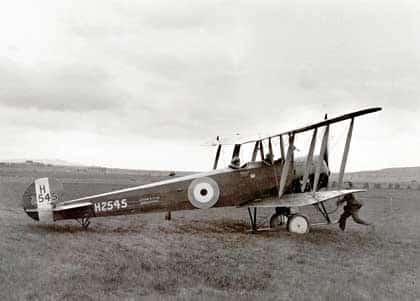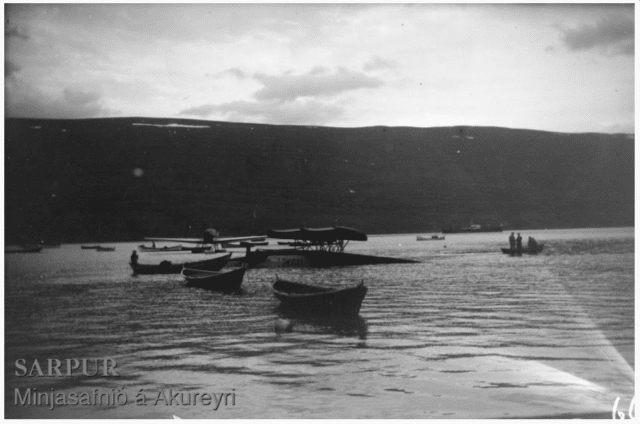
Aviation in Iceland started with an airline, not an aircraft. Flugfélag Íslands, the first Icelandic airline, was founded in Reykjavík on the 22nd of March 1919. They did not (yet) have an aeroplane.
This was just a few weeks after William Boeing had a C-700 built for himself to explore the exciting new prospect of airmail delivery.On the 3rd of March, William Boeing and Eddie Hubbard flew 60 letters from Vancouver, BC, Canada to Seattle, Washington in the US, making for North America’s first international mail delivery. By now, it was clear that aviation was going to change the world. The 1919 Paris Convention had just started producing a set of fundamental principles to regulate aerial navigation.
And Flugfélag Íslands bought an Avro 504K, which arrived in a crate ready for them to screw back together.
The Avro 504 was an obvious choice. It was used by the Royal Flying Corps and Royal Naval Service during the First World War. It quickly became obsolete as a frontline aircraft. Still, it found its niche as a trainer, leading to the mass production of nine thousand aircraft during the war and another two thousand in the years following.
Another benefit of the 504K is that it was designed with a universal mount, which meant it could take a range of engines, an important consideration for running an airline on an island. The Avro 504K had been owned by the British Royal Airforce and still held its RAF registration of H2545 when Magnús Ólafsson took this photo.

Flugfélag Íslands (literally Iceland Airlines) already had a runway, as the British had built an airfield at Vatnsmýrin during the war and then handed it over to the Icelanders when the conflict finished.
The first flight in Iceland was on the 3rd of September 1919, when a Danish pilot, Cecil Faber, took off from Vatnsmýri in a Flugfélag Íslands aircraft, a two-seater AVRO 504K. He circled Reykjavík, to the delight of the inhabitants.
Flugfélag Íslands spent the following summer organising air shows and selling sightseeing flights. They planned to offer flights around the country, but landing conditions were not good outside of Reykjavík and the airline soon ran into financial difficulties, closing down in 1920.
However, the airline’s name had become synonymous with Icelandic aviation and a few years later, it was adopted by a new operation working in collaboration with the German airline Lufthansa. This version of Flugfélag Íslands started in 1928 with a Junkers F13, which they named Súlan. They were more successful, quickly purchasing a second aircraft named Veiðibjalla. They offered domestic flights five times a week and leased aircraft to the government for herring spotting. In 1930, they replaced the two aircraft with new Junkers which were given the same names, which isn’t confusing at all. Anyway, a year later, both aircraft were damaged in accidents and the airline shut down in 1931.
Arthur Charles Gook was an interesting man who did many things, but the thing that is most interesting to us is that he settled in Akureyri as a missionary in 1905. There, he took this photograph of an overturned Junkers W-33. If I can trust the machine translation, it says that Súlan was moored in Akureyri when a squall led to it “taking off” and flipping onto its back in 1 metre of water.

The third airline bearing the name Flugfélag Íslands was founded in Akureyri in 1937 as Flugfélag Akureyrar, offering flights between Reykjavík and Akureyri. They purchased an American Waco aircraft and converted it to a seaplane, registering it in Iceland as TF-ÖRN (örn is the Icelandic word for eagle). In 1940, the airline moved to Reykjavík and changed their name to, you guessed it, Flugfélag Íslands. The Managing Director, a newly qualified pilot, was also named Örn, Örn O. Johnson, to be precise. The aircraft TF-ÖRN crashed into an Army hut during a mail flight a year later. Aviation Safety Network says it was repaired but Icelandair says it was scavenged for parts to make a new plane. Shortly after its maiden flight, the second TF-ÖRN crashed in 1942.
Despite the drama, this third version of Flugfélag Ísland managed to struggle through and started to offer scheduled flights in the 40s, offering a continuous flight service in the decades that followed. In 1973, after many changes in legislation and mergers and name-changes, Flugfélag Ísland became Icelandair. Our eagle friend Örn O. Johnson was still there and was one of two appointed to manage the new airline.
But that wasn’t the end for Flugfélag Ísland! In 1997, Icelandair created a subsidiary for domestic flights and revived the name for its regional airline based in Akureyri. This fourth version of Flugfélag Ísland lasted for twenty years, when the airline changed its name to Air Iceland Connect. In 2021, Icelandair and Air Iceland Connect integrated again and domestic flights are once again under the Icelandair banner.
All this to tell you that I’m flying with Icelandair this weekend, first using their international service to Keflavík and then reviewing their domestic service for a flight from Reykavík to Akureyri. I’ll be in Iceland for six weeks, as I’ve been invited for a monthlong writer’s residency on a small island near Akureyri.
Don’t worry, you’ll still get an article every week, including some guest posts and I’m hoping for an exploration of the Hollvinafélag Aviation Museum in Akureyri. But newsworthy events–of which there will hopefully be few!–will be put off until April.
References:
- https://www.mbl.is/frettir/innlent/2017/05/31/nafnid_a_naerri_100_ara_sogu/
- https://en.wikipedia.org/wiki/Reykjav%C3%ADk_Airport
- https://www.sarpur.is/Adfang.aspx?AdfangID=2380329
- https://www.icelandair.com/about/history/flying-since-1937/
- https://aviation-safety.net/wikibase/226402
- https://aviation-safety.net/wikibase/157943
Discover more from reviewer4you.com
Subscribe to get the latest posts to your email.





